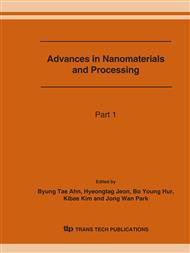p.1809
p.1813
p.1817
p.1821
p.1825
p.1829
p.1833
p.1837
p.1841
Adsorption Properties of Activated Carbon Fibers Characterized by Electric Decomposition
Abstract:
Pitch based activated carbon fibers(ACFs) were characterized by electric decomposition method in the various kinds of acid electrolyte. The felt-type commercialized ACFs were used as raw material and the acids such as HCl, H2SO4, HNO3 and HF were used as electrolytes for electric decomposition. ACFs were treated with 0.7 ~ 2.0A/g-ACF of DC as an anode material for few hours in the acid electrolyte bath and voltage was varied 10~50V according to the condition of current and electrolyte. The pore properties of surface characterized ACFs were measured by adsorption analyzer and changes of surface morphology were also observed by scanning electron microscope and transmitting electron microscope. In order to estimate possibility of use as hydrogen storage material, hydrogen adsorption amount was measured with high pressure thermogravimetric analyzer. In the result the pore size distribution of surface characterized ACFs were changed with respect to electric decomposition condition, especially species and concentration of electrolytes and hydrogen adsorption amount also changed according to pore properties of ACFs.
Info:
Periodical:
Pages:
1837-1840
Citation:
Online since:
June 2007
Authors:
Keywords:
Price:
Сopyright:
© 2007 Trans Tech Publications Ltd. All Rights Reserved
Share:
Citation:


